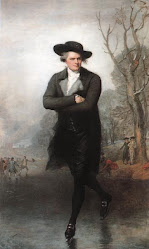
President Monroe's portrait just below, no hands. Meeker's first cousin and a business partner (click here) William Meeker, no hands. (W. Meeker was posted in Liverpool, and died on a sea voyage back to New Orleans in 1812.)
THE WORLD OF SAMUEL MEEKER, MERCHANT OF PHILADELPHIA, AND GILBERT STUART, AMERICAN PORTRAIT ARTIST

 James Monroe (April 28, 1758 – July 4, 1831) was the fifth President of the United States (1817–1825). Monroe was the last president who was a Founding Father of the United States, most noted for his proclamation of the Monroe Doctrine in 1823, which stated that the United States would not tolerate further European intervention in the Americas.
James Monroe (April 28, 1758 – July 4, 1831) was the fifth President of the United States (1817–1825). Monroe was the last president who was a Founding Father of the United States, most noted for his proclamation of the Monroe Doctrine in 1823, which stated that the United States would not tolerate further European intervention in the Americas.
The letter is quoted from “Gilbert Stuart” by Barratt and Miles, p 312, it is taken from the Horace Holley Papers, letter L40, William L. Clements Library, University of Michigan, Ann Arbor.

Samuel Meeker (1763-1831) was a man who seemed to be able to balance his life between the creation of wealth in the financially flourishing city Philadelphia, and the pursuit of happiness in the undisturbed quiet of nature at his country estate "Fountain Green" on the banks of the Schuylkill River. Commerce, vitalized by the Protestant ethic and the spirit of capitalism, was let loose in America. Win or lose, that was the risk, and Meeker rose to the challenge.
For a thorough overview of the story of Samuel Meeker, check out my article in the spring issue 2013 of the publication "Financial History." This is a publication connected to the History of Finance Museum at the Smithsonian.
This is a report on Samuel Meeker, the man in the portrait; who he is, the story of the portrait in my family, his ancestors and descendants (including myself and my daughter Lily), and last but not least Gilbert Stuart the artist, his sitters, and their stories. Gradually, with light being shed on these individuals at the turn of the century, life in Philadelphia begins to shine through...the good, the bad, the scintilating, &...the titillating!
For a closer view of a photo or graphic, click directly on it.As I began to research the identity of the painter of this family portrait (confidently reported by family to be by Peale), I ...1) figured out it was done by the artist Gilbert Stuart and ...2) the character of the artist began to interest me as much as my relative. Thus this report also reflects my continuing fascination with ...Gilbert Stuart...In addition to reading posts, the 'comments' might also be of interest (just click on the word 'comments' at the bottom of the post), to read more relevant info/insights to the posts. Feel free to add your own comments as well! To those of you who make comments on older posts, just beware that I most likely will not see them, but other viewers will.
Elizabeth



Ich habe überdies eine grosse Liebe für die Vergangenheit. Nur was sie gewährt, ist ewig und unveränderlich wie der Tod und zugleich wie das Leben warm und beglückend.
Wilhelm von Humboldt
Ein frohes heiteres Gemüt ist die
Quelle alles Edlen and Guten; das
Größte und Schönste, was je geschah,
floß aus einter solchen Stimmung.
Friedrich von Schiller

